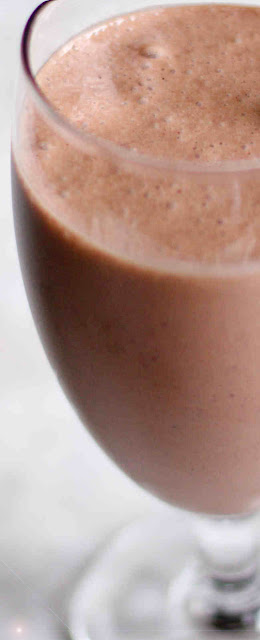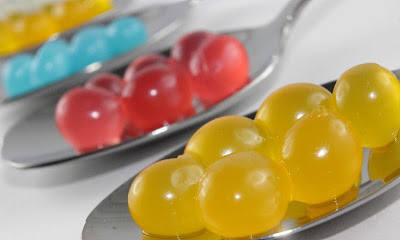Exceptional food that worth a special journey. And all other foods that can kill you.
Wednesday
Creamy Coffee Milkshake- Eat Nourish Glow Recipes
If you like coffee in the morning, well here is a healthy version that will wake-up your taste buds as well as delivering a gelatin protein boost. You will know you are onto a good thing.
Prep time: 5 minutes
Freeze time: 30 minutes
Serves 1–2
INGREDIENTS:
Protein cubes:
1 tbsp grass-fed gelatin powder (can be bought online from Amazon.com)
125ml organic tinned coconut milk
250ml hot espresso
1/2 tsp coconut crystals (optional)
A small pinch of sea salt
Milkshake:
250ml espresso
250ml coconut milk
1 tbsp coconut butter
A pinch of vanilla powder
4 protein cubes
4 ice cubes
PREPARATION PROCEDURE:
1) For the protein cubes, sprinkle the gelatin over the cold coconut milk and stir until the gelatin has dissolved and a paste has formed. Leave to rest for a few minutes, then pour the hot espresso on top and stir.
2) Add the coconut crystals (if using) and the salt, then pour the mixture into ice-cube trays.
3) Freeze for 30 minutes to cool.
4) This makes more than enough protein cubes so you have extra for other days.
5) To make the milkshake, put all the ingredients into the blender and blend until combined.
6) Serve.
Quick Tips:
How long should I refrigerate the gelatin?
Gelatin readily dissolves in hot water, and sets to a gel on cooling. Gelatin added directly to cold water does not dissolve well. Different gelatin recipes will require different techniques and refrigeration times.
The gelatin should be the consistency of an extremely dense pudding. Keep it in the fridge for approximately 1 hour and 30 minutes (depending on the volume, thickness, and chilling temperature. You need it like this so you can suspend coconut crystals in the gelatin.
Why Use Gelatin?
Gelatin is a natural foodstuff. Chemically, gelatin is a pure protein. Gelatin is unusually high in amino acids Glycine and Proline. It is found in most gummy candy as well as other products such as marshmallows, gelatin dessert, and some ice cream, dip and yogurt.
What are the Vegetarian Alternatives for Gelatin?
Pectin can be used as a gelatin substitute, but is not generally recommended due to the acid and sugar required for proper gelling. It can be tricky to get the right flavor and texture. The Vegetarian Society suggests agar or carrageenan, both of which are derived from seaweed. Like gelatin, they are flavorless and only require water to work. They also are considered easier to use.
Try another healthful and delicious recipe. Cook this; it's easy... How to Make Parsnip Fritters: Eat Nourish Glow Recipes
My reference for this tasty and healthful recipe is this book:
Freer, Amelia. 2015. Eat. Nourish. Glow.: 10 easy steps for losing weight, looking younger & feeling healthier. Harper Thorsons. ISBN-10: 000757990X
About the Author
Nutritional therapist and healthy eating expert Amelia Freer has helped her many celebrity clients, including James Corden and Sam Smith, to dispatch fad diets to the distant past whilst guiding them to a rejuvenated future. Now she can do the same for you. Her ideas are all backed up by the latest findings in the field of nutrition and neuroscience.
Amelia Freer brings a fresh and unique voice to the field of holistic health. In this, her first book, she explains her 10 steps and provides over 25 enticing recipes to get you started on your path to optimum wellness.
Amelia includes a mouth-watering selection of recipes, from delightful breakfast alternatives, such as Almond, Apricot and Rose Yogurt, light lunch ideas such as Crunchy Crab Salad and delicious mains such as Monkfish with a Broccoli and Ginger Mash. Wow your friends with the fiendish yet healthy sweet alternatives such as the Salted Caramels.
Share this recipe and feel good! :-)
Prep time: 5 minutes
Freeze time: 30 minutes
Serves 1–2
INGREDIENTS:
Protein cubes:
1 tbsp grass-fed gelatin powder (can be bought online from Amazon.com)
125ml organic tinned coconut milk
250ml hot espresso
1/2 tsp coconut crystals (optional)
A small pinch of sea salt
Milkshake:
250ml espresso
250ml coconut milk
1 tbsp coconut butter
A pinch of vanilla powder
4 protein cubes
4 ice cubes
PREPARATION PROCEDURE:
1) For the protein cubes, sprinkle the gelatin over the cold coconut milk and stir until the gelatin has dissolved and a paste has formed. Leave to rest for a few minutes, then pour the hot espresso on top and stir.
2) Add the coconut crystals (if using) and the salt, then pour the mixture into ice-cube trays.
3) Freeze for 30 minutes to cool.
4) This makes more than enough protein cubes so you have extra for other days.
5) To make the milkshake, put all the ingredients into the blender and blend until combined.
6) Serve.
Quick Tips:
How long should I refrigerate the gelatin?
Gelatin readily dissolves in hot water, and sets to a gel on cooling. Gelatin added directly to cold water does not dissolve well. Different gelatin recipes will require different techniques and refrigeration times.
The gelatin should be the consistency of an extremely dense pudding. Keep it in the fridge for approximately 1 hour and 30 minutes (depending on the volume, thickness, and chilling temperature. You need it like this so you can suspend coconut crystals in the gelatin.
Why Use Gelatin?
Gelatin is a natural foodstuff. Chemically, gelatin is a pure protein. Gelatin is unusually high in amino acids Glycine and Proline. It is found in most gummy candy as well as other products such as marshmallows, gelatin dessert, and some ice cream, dip and yogurt.
What are the Vegetarian Alternatives for Gelatin?
Pectin can be used as a gelatin substitute, but is not generally recommended due to the acid and sugar required for proper gelling. It can be tricky to get the right flavor and texture. The Vegetarian Society suggests agar or carrageenan, both of which are derived from seaweed. Like gelatin, they are flavorless and only require water to work. They also are considered easier to use.
Try another healthful and delicious recipe. Cook this; it's easy... How to Make Parsnip Fritters: Eat Nourish Glow Recipes
My reference for this tasty and healthful recipe is this book:
Freer, Amelia. 2015. Eat. Nourish. Glow.: 10 easy steps for losing weight, looking younger & feeling healthier. Harper Thorsons. ISBN-10: 000757990X
About the Author
Nutritional therapist and healthy eating expert Amelia Freer has helped her many celebrity clients, including James Corden and Sam Smith, to dispatch fad diets to the distant past whilst guiding them to a rejuvenated future. Now she can do the same for you. Her ideas are all backed up by the latest findings in the field of nutrition and neuroscience.
Amelia Freer brings a fresh and unique voice to the field of holistic health. In this, her first book, she explains her 10 steps and provides over 25 enticing recipes to get you started on your path to optimum wellness.
Amelia includes a mouth-watering selection of recipes, from delightful breakfast alternatives, such as Almond, Apricot and Rose Yogurt, light lunch ideas such as Crunchy Crab Salad and delicious mains such as Monkfish with a Broccoli and Ginger Mash. Wow your friends with the fiendish yet healthy sweet alternatives such as the Salted Caramels.
Share this recipe and feel good! :-)
Subscribe to:
Post Comments (Atom)


No comments:
Post a Comment